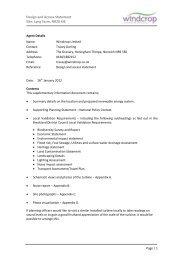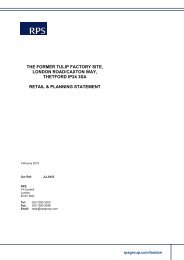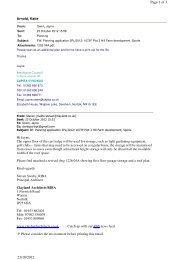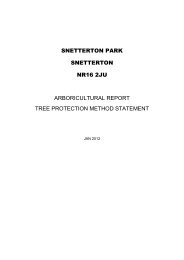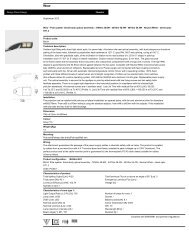HERITAGE STATEMENT ST PETERS CHURCH THETFORD For THETFORD COUNCIL
Heritage%20Statement%20February%202013.pdf
Heritage%20Statement%20February%202013.pdf
You also want an ePaper? Increase the reach of your titles
YUMPU automatically turns print PDFs into web optimized ePapers that Google loves.
have it brought from Norwich. From the Churchwardens Accounts it can also be seen what other<br />
payments were made for the general maintenance and repair of the church and fabric. One<br />
frequent payment was for new bell ropes and “the ringers”.<br />
Towards the later part of the 1780s it was obvious that major restoration was needed to maintain<br />
the tower and by early 1789 it had been decided to start a public subscription for, not only<br />
rebuilding the tower, but enlarging and rebuilding the church and altering the churchyard. Lord<br />
Petre (Lord of the Manor of Thetford) immediately contributed £500 towards the rebuilding.<br />
Subscriptions eventually totaled £1,239 but there was still a deficiency of £845 16s. To meet this,<br />
a rate of 2 shillings in the pound was levied on the parish rate payers until the debt was fully<br />
discharged. How popular this rate was is not known, but I guess there must have been at least a<br />
few objectors, particularly from the growing number of non-conformists who lived in the parish.<br />
Less than ten years earlier the rate was just 11d. in the pound. It was over a 100% increase! Even<br />
at the end of the 19 th Century the parish rate was only 1s. 6d. in the pound.<br />
The St Peter’s Church that we have inherited is very much the church rebuilt between 1789 – 91<br />
and when major restoration took place just over a century later. Between 1789 – 91 the tower was<br />
demolished and rebuilt but no longer on the arches described earlier in the 18 th Century. A new<br />
peel of bells was also hung in the tower. The old south porch was completely cleared and a new<br />
main entrance into the church was created in the new west tower. Where the porch had stood, a<br />
new stone window was erected. The vestry, once St Katherine’s Chapel, was demolished and a<br />
new vestry was built at the east end of the north aisle.<br />
The old lead was removed from the chancel roof and sold to be replaced with slate, as was the<br />
roof of the Nave. Inside the church a new pulpit was installed as were new pews, a new<br />
communion table and rail. At the east end of the chancel, a new “and finely executed window of<br />
stained glass” was designed, made and fitted by Mr. George Bird Burrell. George Burrell’s bull<br />
for painting and glazing cam to £111 9s. 11 3/4d. Another member of the Burrell family involved<br />
with the restoration work was Joseph Burrell who was paid £18 6s. 9 3/4d for smiths’ work.<br />
Joseph Burrell’s brother, James Burrell was a churchwarden in the 1820s and the father of the<br />
famous, Charles Burrell (1817-1906). One parishioner, James Mingay, paid for a new and<br />
handsome chandelier for the middle aisle of the church and also for iron pallisading around the<br />
new churchyard wall.<br />
In March 1791, at the completion of the extensive work, the new peel of eight bells, cast by<br />
Thomas Osborn, bell founder, of Downham Market were rung. Not only were the local bell<br />
ringers there for the occasion but ringers from different parts of Norfolk, Suffolk and<br />
Cambridgeshire. Everyone seemed well satisfied with the restoration work and the quality of the<br />
new bells which Mr. Osborn has been paid the sum of £364 –s 9d. which included the old bells.<br />
Incidentally, these new bells weigh over 3.5 tons. As one observer reported, St Peter’s Church<br />
had been “completely repaired and beautified”.<br />
The parishioners were also now installed in their new and respective pews. There was a strict<br />
allocation of pews for such as the parish elite, members of the Corporation, Boys of the Grammar<br />
School, The George inn and the Abbey Farm. The pews in the middle aisle were reserved for the<br />
wives of tradesmen. It was still the practice, in the latter part of the 18 th century, for men and<br />
women to sit in separate pews at Service time.<br />
Despite the extensive improvements towards the end of the 18 th Century, changes to the fabric of<br />
St Peter’s Church continued once again in the second half of the 19 th Century. A new organ, paid<br />
by public subscription, was erected in a gallery at the west end in 1853. Repairs to the tower were<br />
undertaken in 1863 and four years later, subscriptions were sought for a new clock in the tower –<br />
the present clock. In 1870 a new stained glass east window, was inserted by Shelford Bidwell,<br />
replacing George Bird Burrell’s window. In 1875 the bells were re-hung once again.




